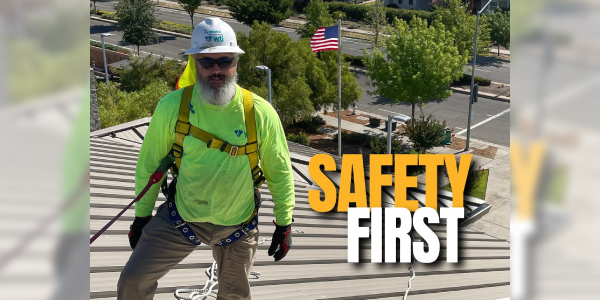UP TO THE MINUTE
How roofing contractors can foster a safer work environment
November 28, 2024 at 12:00 p.m.By Cotney Consulting Group.
A successful safety program requires more than employee buy-in; it needs strong leadership.
The construction industry poses unique health and safety challenges for workers, particularly roofing. According to OSHA, about one in five workplace deaths were construction-related. However, effective health and safety processes can minimize these risks and safeguard workers. Creating a strong safety culture is about implementing rules and fostering a mindset that prioritizes the well-being of every employee on the job site.
Here's how roofing contractors can benefit from these strategies to ensure a safer work environment.
The importance of a safety culture
The concept of "safety culture" emerged after the Chornobyl disaster in 1986 to describe how the behaviors and attitudes of workers contributed to the accident. Decades later, fostering a safety culture remains a challenge for many construction companies. For roofing contractors, establishing this culture is crucial — not just for minimizing health risks but also for boosting morale, improving quality and production and enhancing the company's reputation.
A safety management program that prioritizes employee buy-in can have widespread positive effects, including:
- Quality and production improvements: Safe work environments lead to fewer accidents, which means uninterrupted workflow and better productivity.
- Employee morale: Workers are more satisfied and confident in a company that values their well-being.
- Recruiting and retention: A strong safety culture can attract skilled workers and keep them long-term.
- Reputation: Customers, suppliers and the community view safety-conscious companies more favorably.
However, the effectiveness of a safety program relies on more than just written policies; it requires active participation and commitment from everyone, from top management to front-line workers.
Overcoming barriers to employee buy-in
Despite the clear benefits, gaining employee buy-in for a safety culture can be difficult. Common barriers include:
- Lack of awareness: Workers may be unaware of potential hazards and thus resistant to the changes needed to avoid them.
- Organizational growth: Rapid expansion can result in a lack of emphasis on safety practices.
- Time constraints: Workers may feel they lack the time to follow safety protocols.
- Disinterest: Some employees may not view safety as relevant until they experience an incident firsthand.
- Management involvement: Lack of management engagement can undermine the importance of safety.
To address these challenges, roofing contractors need a strategic approach to build and sustain a safety culture.
Strategies to achieve buy-in
Creating a company-wide commitment to safety starts with thoughtful planning, clear communication and positive reinforcement. Here are four key strategies to help roofing contractors gain buy-in from their team:
1 - Implement a safety incentive program
You should utilize a rewards system where employees receive gift cards or apparel for consistently following safety protocols. Recognizing and rewarding safe behavior motivates employees and demonstrates that the company values safety. This positive reinforcement can extend beyond the job site, showing workers' families that their safety is a priority. The incentive program should be simple and rewards should be frequent to reinforce daily safety practices.
2 - Take an individual approach
While rewards programs are effective, personal interaction is equally important. Employees need to feel heard and have an open platform to discuss safety issues without fear of blame or punishment. By fostering open communication, contractors can gain valuable feedback on safety concerns and create an environment where employees feel empowered to contribute to the safety culture.
3 - Enforce safety measures consistently
A written policy is only part of the equation; enforcement is key. Upper management must clearly demonstrate that safety is a priority by holding everyone accountable. I recommend giving employees and field leaders ownership in developing and enforcing safety policies. When employees are actively involved in the process, they are more likely to adhere to and promote the guidelines among their peers.
4 - Use checklists and technology
Integrating checklists into daily operations is an effective way to reinforce safety protocols. By using safety solutions that allow for company-wide monitoring, audit scheduling and reminders, you can help turn safety practices into a routine part of every workday. Utilizing technology like dashboards and custom reports can provide valuable insights into trends, compliance and areas for improvement.
The role of strong leadership in safety
A successful safety program requires more than employee buy-in; it needs strong leadership. Leaders must model safe behavior, address resistance promptly and communicate the importance of safety in every aspect of work. I advise against an authoritarian "safety cop" approach, which can create resentment and resistance among workers. Instead, safety leaders should speak to employees in their terminology and draw on past experiences to relate to the job demands.
When hiring safety managers, prioritize their qualifications, construction experience and ability to connect with workers. Leadership should be seen as a safety resource, maintaining composure and approachability to foster trust and cooperation.
Boosting your roofing safety program
In addition to employee buy-in and leadership, consider these key areas to enhance your safety program:
1 - Continuous safety training
Safety training is not a one-time event; it must be ongoing. With regulations, equipment and project requirements constantly evolving, regular training ensures that workers are up-to-date on the latest safety practices and standards.
2 - Proper tools and equipment
Workers should never start a job without the proper tools and equipment. Emphasize the importance of using the right equipment for every task, no matter how small, to prevent accidents.
3 - Compliance tracking
Having a centralized system to track compliance is essential. Monitoring adherence to safety procedures ensures that your program is effectively implemented and that employees follow proper protocols.
4 - Contractor safety
Large construction projects often involve multiple contractors. Ensure your employees and subcontractors on your job site follow your organization's safety rules and procedures, maintaining consistent standards across the board.
5 - Scheduling and budgeting
Safety should be prioritized alongside schedule and budget. A healthy workforce is a cost-effective one, and cutting corners on safety can lead to expensive accidents and potential lawsuits. According to The Center for Construction Research and Training, the construction industry incurs nearly $13 billion in costs annually due to injuries.
6 - Adaptations for an aging workforce
Injuries tend to be more severe among older workers. To mitigate this risk, ergonomic working practices should be provided and lighter tools and materials should be considered to reduce strain.
7 - Leveraging technology
Use technology to collect data, identify trends and share information with all stakeholders. Real-time insights can lead to more informed decisions and a proactive approach to safety.
Conclusion
Creating a safety culture in roofing goes beyond policies and procedures; it requires the commitment of every individual within the company. By fostering a culture where safety is integrated into daily operations, roofing contractors can reduce the risk of accidents and improve employee morale, enhance productivity and protect their business's reputation. Achieving a safe work environment is possible but requires ongoing leadership, resources and a commitment to embedding safety into the company's core values.
Learn more about Cotney Consulting Group in their Coffee Shop Directory or visit www.cotneyconsulting.com.






















Comments
Leave a Reply
Have an account? Login to leave a comment!
Sign In